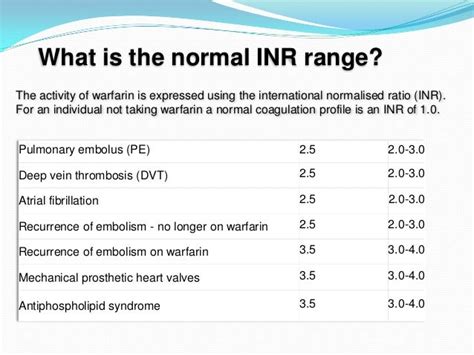Intro
Discover the importance of PT INR range in blood clotting, including normal INR range, high INR levels, and low INR levels, to manage anticoagulation therapy and prevent thrombosis or bleeding complications.
The importance of maintaining a healthy PT INR range cannot be overstated, as it plays a crucial role in preventing blood clots and strokes in individuals taking warfarin. PT INR, or prothrombin time-international normalized ratio, is a test used to measure the time it takes for blood to clot and is essential for patients on anticoagulant therapy. A PT INR range of 2.0 to 3.0 is typically considered the target range for most patients, but this can vary depending on individual circumstances. In this article, we will delve into the world of PT INR ranges, exploring the importance of maintaining a healthy range, the risks associated with being outside of this range, and providing practical tips for managing and maintaining a stable PT INR.
For patients taking warfarin, regular monitoring of their PT INR range is vital to ensure that their blood is not too prone to clotting or bleeding. Being outside of the target PT INR range can have serious consequences, including an increased risk of blood clots, strokes, or bleeding complications. Furthermore, maintaining a stable PT INR range can be challenging due to various factors such as diet, medications, and lifestyle changes. Therefore, it is essential for patients to be aware of the factors that can influence their PT INR range and take proactive steps to manage it effectively.
Maintaining a healthy PT INR range is a delicate balance that requires careful monitoring and management. Patients must work closely with their healthcare providers to adjust their warfarin doses and make lifestyle changes to achieve and maintain a stable PT INR range. This may involve regular blood tests, dietary modifications, and avoiding certain medications or activities that can interact with warfarin. By understanding the importance of PT INR ranges and taking proactive steps to manage them, patients can reduce their risk of complications and improve their overall health and well-being.
Understanding PT INR Ranges

Factors Influencing PT INR Ranges
Several factors can influence PT INR ranges, including diet, medications, and lifestyle changes. For example, consuming large amounts of vitamin K-rich foods, such as leafy green vegetables, can decrease PT INR levels, while certain medications, such as antibiotics, can increase PT INR levels. Additionally, changes in lifestyle, such as increased physical activity or travel, can also affect PT INR ranges. Patients must be aware of these factors and take proactive steps to manage them effectively.Managing PT INR Ranges

Practical Tips for Maintaining a Stable PT INR Range
Here are some practical tips for maintaining a stable PT INR range: * Eat a consistent diet that is low in vitamin K-rich foods * Avoid taking certain medications that can interact with warfarin * Limit alcohol consumption and avoid binge drinking * Stay hydrated and avoid dehydration * Get regular exercise, but avoid excessive physical activity * Manage stress and get enough sleepRisks Associated with Being Outside of the Target PT INR Range

Consequences of Being Outside of the Target PT INR Range
The consequences of being outside of the target PT INR range can be severe and potentially life-threatening. Some of the possible consequences include: * Blood clots: If the PT INR range is too low, the blood may be too prone to clotting, increasing the risk of blood clots and strokes. * Bleeding complications: If the PT INR range is too high, the blood may be too prone to bleeding, increasing the risk of bleeding complications. * Stroke: If the PT INR range is too low, the blood may be too prone to clotting, increasing the risk of stroke. * Heart attack: If the PT INR range is too low, the blood may be too prone to clotting, increasing the risk of heart attack.Monitoring PT INR Ranges

Frequency of Monitoring PT INR Ranges
The frequency of monitoring PT INR ranges depends on individual circumstances, such as the patient's medical history and the presence of any underlying conditions. Generally, patients taking warfarin should have their PT INR range checked regularly, ideally every 2-4 weeks. However, this frequency may vary depending on individual circumstances, and patients should follow the advice of their healthcare provider.Maintaining a Healthy Lifestyle

Importance of a Balanced Diet
A balanced diet is essential for maintaining a healthy PT INR range. Patients should eat a consistent diet that is low in vitamin K-rich foods and avoid making sudden changes to their diet. They should also stay hydrated and avoid dehydration, which can affect PT INR levels.Conclusion and Next Steps

We invite readers to share their experiences and tips for managing PT INR ranges in the comments below. If you have any questions or concerns about PT INR ranges, please do not hesitate to ask. By working together, we can promote awareness and education about the importance of PT INR ranges and improve patient outcomes.
What is the target PT INR range for most patients?
+The target PT INR range for most patients is 2.0 to 3.0, but this can vary depending on individual circumstances.
What factors can influence PT INR ranges?
+Several factors can influence PT INR ranges, including diet, medications, and lifestyle changes.
How often should PT INR ranges be monitored?
+PT INR ranges should be monitored regularly, ideally every 2-4 weeks, but this frequency may vary depending on individual circumstances.
